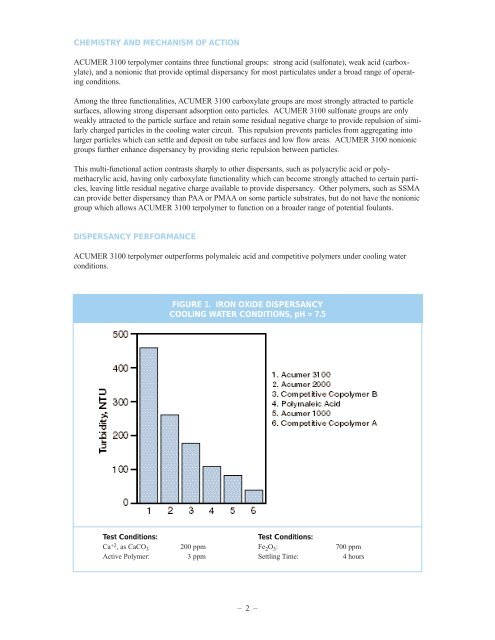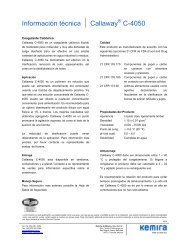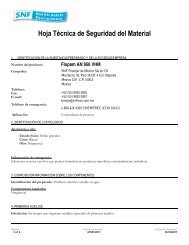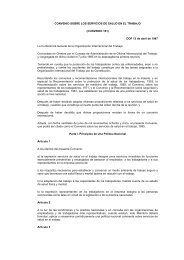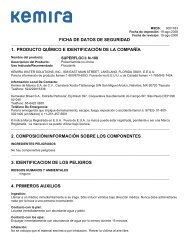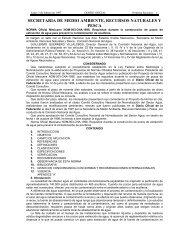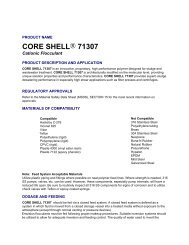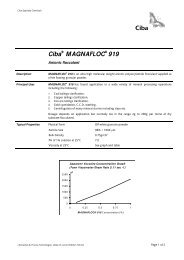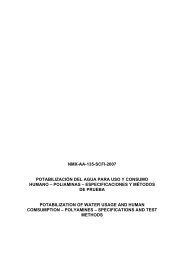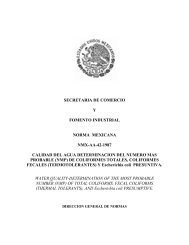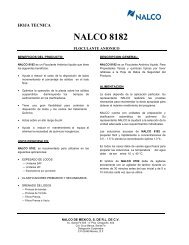ACUMER 3100 Terpolymer The Anti-Scale Deposition for ...
ACUMER 3100 Terpolymer The Anti-Scale Deposition for ...
ACUMER 3100 Terpolymer The Anti-Scale Deposition for ...
You also want an ePaper? Increase the reach of your titles
YUMPU automatically turns print PDFs into web optimized ePapers that Google loves.
CHEMISTRY AND MECHANISM OF ACTION<br />
<strong>ACUMER</strong> <strong>3100</strong> terpolymer contains three functional groups: strong acid (sulfonate), weak acid (carboxylate),<br />
and a nonionic that provide optimal dispersancy <strong>for</strong> most particulates under a broad range of operating<br />
conditions.<br />
Among the three functionalities, <strong>ACUMER</strong> <strong>3100</strong> carboxylate groups are most strongly attracted to particle<br />
surfaces, allowing strong dispersant adsorption onto particles. <strong>ACUMER</strong> <strong>3100</strong> sulfonate groups are only<br />
weakly attracted to the particle surface and retain some residual negative charge to provide repulsion of similarly<br />
charged particles in the cooling water circuit. This repulsion prevents particles from aggregating into<br />
larger particles which can settle and deposit on tube surfaces and low flow areas. <strong>ACUMER</strong> <strong>3100</strong> nonionic<br />
groups further enhance dispersancy by providing steric repulsion between particles.<br />
This multi-functional action contrasts sharply to other dispersants, such as polyacrylic acid or polymethacrylic<br />
acid, having only carboxylate functionality which can become strongly attached to certain particles,<br />
leaving little residual negative charge available to provide dispersancy. Other polymers, such as SSMA<br />
can provide better dispersancy than PAA or PMAA on some particle substrates, but do not have the nonionic<br />
group which allows <strong>ACUMER</strong> <strong>3100</strong> terpolymer to function on a broader range of potential foulants.<br />
DISPERSANCY PERFORMANCE<br />
<strong>ACUMER</strong> <strong>3100</strong> terpolymer outper<strong>for</strong>ms polymaleic acid and competitive polymers under cooling water<br />
conditions.<br />
FIGURE 1. IRON OXIDE DISPERSANCY<br />
COOLING WATER CONDITIONS, pH = 7.5<br />
Test Conditions:<br />
Test Conditions:<br />
Ca +2 , as CaCO 3 200 ppm Fe 2 O 3 : 700 ppm<br />
Active Polymer: 3 ppm Settling Time: 4 hours<br />
–2–


